#photographythe
Explore tagged Tumblr posts
Link
0 notes
Text
Fine Art Photography: A Complete Guide for Artists & Art Lovers
Fine Art Photography: A Complete Guide for Artists & Art Lovers This article is a guide to fine art photography, covering its history, styles and the role of the photographer. It’s aimed at both artists interested in the medium and art lovers who want to understand it better. Key points of the article:Definition of Fine Art PhotographyHistory of Fine Art PhotographyThe Role of the Photographer…
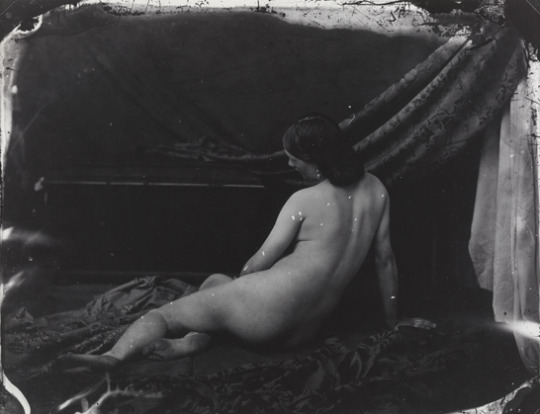
View On WordPress
0 notes
Link
0 notes
Text
SEO Specialist for Boudoir Photographers | Boost Visibility
Embark on a journey to elevate your boudoir photography business with the strategic insights of Simon Hogben, a seasoned Boudoir Photography Marketing Specialist. Harness two decades of expertise in sales and marketing as Simon, a distinguished digital marketing expert, guides you through the intricacies of SEO. Unlock the potential of savvy online marketing and watch as your boudoir studio's visibility soars, attracting the clientele you deserve.
Key Takeaways
Understand the transformative power of SEO to enhance your boudoir photography business's online prominence.
Leverage the expertise of Simon Hogben, a digital marketing expert, to fine-tune your marketing strategy.
Employ strategic SEO tools like Google Analytics & CrazyEgg for real-time performance monitoring.
Adopt targeted keyword research to captivate the right audience and maximize engagement.
Benefit from personalized SEO consultations to construct a bespoke online brand that stands out.
Discover the hidden potential of your website with a tailored SEO plan that drives traffic and conversions.
Gain insights into industry-specific SEO tactics for boudoir photography that yield tangible results.
The Essential Role of SEO for Boudoir Photographers
As a boudoir photographer, your artistry captures more than just images; it embodies confidence, intimacy, and beauty. But how do you ensure that the intimate portraiture you create reaches the eyes of potential clients? The answer lies in the mastery of Search Engine Optimization (SEO), a critical tool that can catapult your online visibility and draw prospective clients to your boudoir photography website.
Why SEO is a Game-Changer in Boudoir Photography
The journey to Improve SEO for Boudoir Photography starts with understanding its transformative power for your business. In today's digital age, an optimized online presence is no longer optional. It is a necessary pivot for reaching the right audience. Effective SEO strategies place your portfolio front and center when clients search for boudoir photography, thereby enhancing your Online Visibility and increasing your client base.
SEO's magic for boudoir photographers extends beyond general search engine results. It encompasses specific strategies that cater to the visual and emotive nature of boudoir photography. From crafting keyword-rich content that reflects the intimate and personal aspects of your services to optimizing your image-rich site for faster loading times—each SEO tactic is a definitive step towards Google Rankings that can transform your business trajectory.
Structural SEO Enhancements to Propel Your Photography Business
When considering Boudoir Photography Website Optimization, it's essential to recognize the significance of a well-structured website. Your website's URL structure is pivotal, acting as a roadmap for Google's algorithms to understand and rank your content effectively. Integrating clear and logical URLs, paired with strategic internal links, forms the backbone of a website primed for visibility.
Moreover, the cogency of your site's titles and descriptions offers Google critical data to comprehend your web pages' essence. By optimizing these components with the right balance of keywords and descriptive text, search engines are more apt to rank your site favorably, driving significant traffic your way and attracting more of those seeking the cherished art of boudoir photography.
Remember, strategic keyword usage is about balance—too little and you miss the opportunity to rank; too much and you risk the detriment of 'keyword stuffing.' The savviest boudoir photographers wield this balance to not only bolster Google Rankings but to capture the essence of their art, compelling potential clients to enter their studio doors.
Mastering Keyword Research for Boudoir Photography
As a boudoir photographer, diving into the realm of Keyword Research for Boudoir Photography can greatly amplify your website's ranking in search results. To attract your ideal clientele, you must not only identify the right Targeted Key Phrases but also understand how Google's algorithms can work in your favor. This begins with carefully selecting words and phrases that prospective clients are likely to use when seeking services like yours.
Implementing SEO Strategies for Boudoir Photographers involves more than just peppering your website with keywords. It's about strategic placement and relevance to your content. Google's related search suggestions offer a treasure trove of insightful key phrases that can bridge the gap between your content and your audience's search queries.
Your goal is to echo the desires and terminologies used by those seeking intimate portraiture. For instance, terms like 'intimate portraits' or 'glamour photography' could be just the matched pair of keywords resonating with your target audience’s needs.
Remember, balancing keyword use is crucial: Too sparse, and you are invisible; too dense, and you may fall foul of Google's penalties for 'keyword stuffing'. It's the art of subtlety and relevance that wins the search engine game.
Begin by brainstorming keywords related to boudoir photography and the emotions it evokes.
Utilize SEO tools to analyze keyword effectiveness and seek out low-competition, high-search volume options.
Consider your unique offerings and incorporate specific phrases that best describe your specific style or focus within the boudoir niche.
Regularly review and update your keyword strategy to stay ahead of trends and maintain your competitive edge.
By mastering the craft of Keyword Research for Boudoir Photography, you lay down the digital stepping stones that lead clients right to your virtual doorway. Let each keyword serve your artistic vision and elevate your presence within the boudoir community.
Leveraging SEO Tools to Fine-Tune Your Boudoir Brand
Utilizing SEO Tools effectively is like fine-tuning a camera to capture the perfect shot. As a boudoir studio owner or a Boudoir Studio SEO Consultant, your online presence can flourish when you harness the right tools to sharpen your website's visibility in the highly competitive digital landscape. In this era of adaptability, SEO provides an avenue for your brand to not just survive but thrive.
SEMrush, Ubersuggest, and Yoast SEO: The Trifecta for SEO Success
Mastering the art of SEO calls for the use of sophisticated instruments. SEMrush stands out as an all-encompassing platform, catering to your needs for keyword research and social media management. Its extensive capabilities allow you to delve into the depths of SEO with precision, identifying keywords that promise to augment your online visibility. As a remarkable tool for scrutinizing competitors' strategies, SEMrush paves the way for you to step up and make informed decisions.
For those on a tighter budget, Ubersuggest steps in as a commendable free alternative. It simplifies Utilizing SEO Tools by providing valuable insights into keywords and SEO trends without any cost — a boon for boudoir photographers beginning their SEO journey or looking to cut costs without compromising quality.
Unlocking the Full Potential of Your Website with Comprehensive SEO Tools
Wordpress users can rejoice with the Yoast SEO Plugin, a powerful ally in optimizing site metadata. From fine-tuning titles to sprucing up descriptions, the plugin ensures each element of your content is primed to catch Google's sophisticated eye. Yoast facilitates an on-page SEO checklist that gleams with opportunity, guiding you through adjustments that can skyrocket your content's reach and relevance.
Together, SEMrush, Ubersuggest, and the Yoast SEO plugin form a triad of excellence, enabling photographers to transcend the average and achieve the extraordinary. Each tool offers a designated pathway to call forth your inner SEO maestro, unlocking the full breadth of potential housed within your boudoir website. Adopt these tools, and let the symphony of clicks, impressions, and bookings commence.
Deconstructing Competitors' Keywords for Boudoir Dominance
In the realm of boudoir photography, standing out in a saturated market necessitates a strategic edge. That edge is often crafted through meticulous analyzing competitors' keywords. Key to Boudoir Photography SEO Services, this reconnaissance allows you to uncover the search terms leading potential clients to competitors' doorsteps, offering invaluable insight for your own SEO journey.
“In the battle for search engine supremacy, knowledge is power. Understanding which keywords are driving your competitors' success is a crucial piece in the puzzle of online visibility.”
Enhancing your boudoir photographer online visibility commences with dissecting the SEO strategies of others in the trade. A thorough competitor keyword analysis can lead to discoveries that transform your SEO approach, potentially propelling your website up the Google ranks.
Begin by mapping out the most prominent players in your niche and investigating their keyword strategies.
Employ SEO tools designed for analyzing competitors' keywords to benchmark their traffic-generating terms against yours.
Discover high-impact keywords balancing search volume with relevancy, providing a foothold in searches that matter.
Gauge both short-tail and long-tail phrases that encapsulate the essence of boudoir artistry and resonate with your ideal clientele.
Evaluate the strengths and adapt by filling in gaps to outshine your competitors’ SEO efforts.
As you navigate the analytics, remember that the goal of this exercise is to refine your keyword strategy to better align with the queries of those searching for boudoir photography. This is not simply about replication but innovation—adapting and expanding upon these insights to fortify your unique brand presence in the digital landscape.
“Effective SEO is not a one-size-fits-all. It's about translating data into a tailored strategy that speaks directly to your brand and audience.”
Adjust your sails, and with intelligent keyword analysis, set a course for a more visible, compelling online presence that invites engagement and, ultimately, bookings. After all, in this intricate dance with search engines, it is the most perceptive and adaptable boudoir photographers that lead.
SEO Specialist for Boudoir Photographers: Crafting Killer Content
You've got the vision to capture the intimate nuance of boudoir photography, but are you complementing it with content that captivates just as fiercely? As a Boudoir Photography Marketing Specialist, your prowess isn’t just in the photos you take, but also is displayed in the compelling stories and expert insights you share online. This is where the adage 'Content is King' truly resonates. Read on to unveil how to create SEO-Friendly Blog Posts for Boudoir Photography that engage, enlighten, and encourage clicks that convert.
Creating Compelling Blog Posts that Captivate and Convert
In the competitive online world, the allure of your blog content is as crucial as the first page of a novel. It should draw readers into the next chapter - your portfolio, your contact form, your studio. By interweaving striking visuals with a narrative that provides insight into your craft, your blog posts become as seductive as your photography subject matter. These can lead to increased discoverability, encouraging sharing across digital platforms. Hence, infusing your SEO-Friendly Blog Posts for Boudoir Photography with both beauty and brain is non-negotiable.
The Art of Developing Unique and Engaging Content
Avoid the pitfalls of redundancy at all costs. Rather than rehashing old themes, each of your posts should stand as a testament to your unique viewpoint and expertise. By creating fresh, SEO-driven content, you not only signal to Google that your site is a fountain of innovation but also cement your reputation as a leading Boudoir Photography Marketing Specialist. Internal and external links within your text also act as pathways, leading Google’s bots and potential customers alike through a curated journey of your online space. These elements work together to enhance your search engine relevance and ranking, setting you apart in the expansive sea of boudoir photography.
FAQ
How can an SEO specialist help a boudoir photographer?
An SEO specialist, like Simon Hogben, a digital marketing expert, will help boudoir photographers increase their online visibility, improve Google rankings, and attract more clients by optimizing their website, creating strategic content, and using targeted keywords relevant to boudoir photography.
Why is SEO a game-changer in boudoir photography?
SEO is critical for boudoir photographers because it boosts website visibility, helping photographers to rank higher in search engine results and captivate potential customers seeking boudoir photography services.
What structural SEO enhancements can propel a photography business?
Structural SEO enhancements, including a well-organized URL structure, efficient internal linking, and optimized titles and descriptions, are essential for search engines to better understand and index your website, thus improving overall Google rankings and drawing potential clients to your boudoir photography business.
How should boudoir photographers conduct keyword research?
Boudoir photographers should conduct thorough keyword research to identify targeted key phrases that prospective clients might use to search for boudoir photography. They should leverage tools and techniques to find and incorporate these keywords appropriately in their content without overusing them, to optimize search engine rankings and attract the ideal clientele.
What SEO tools can boudoir photographers use to fine-tune their brand?
SEMrush, Ubersuggest, and the Yoast SEO plugin are among the top tools recommended for boudoir photographers. These tools help in identifying potent keywords, studying competitors, refining website content, and building quality backlinks, all of which can substantially enhance a boudoir photographer's online presence.
Why is analyzing competitors' keywords important for boudoir photographers?
Analyzing competitors' keywords allows boudoir photographers to understand which keywords are driving traffic and conversions in their niche. By employing such competitive analysis, photographers can refine their SEO strategy to target these keywords effectively and improve their chances of outranking competitors.
How can creating compelling blog posts improve SEO for boudoir photographers?
Compelling blog posts narrate stories, showcase expertise, and are often shared across social media, leading to increased discovery and backlink opportunities. This fresh, engaging content drives traffic and improves search engine rankings by demonstrating to Google that the photographer's website is a valuable resource for users interested in boudoir photography.
What is the art of developing unique and engaging content for SEO?
Developing unique and engaging content involves crafting posts that offer fresh perspectives, useful information, and a distinctive voice in the field of boudoir photography. This strategic content creation enhances discoverability, encourages social sharing, and builds a photographer's brand, ultimately playing a crucial role in Google's assessment of website quality and relevance.
0 notes
Text
Do you remember the first camera phone you had? It probably had a pixel-heavy, low-quality camera. Fast forward to today, and it's amazing how much technology has changed. Smartphone cameras have evolved in leaps and bounds – you can now capture professional-level photographs with a device that fits right in your pocket. In this article, we'll explore the fascinating evolution of smartphone cameras and the trends that have shaped the most popular features.Table of Contents1. Impact of Smartphone Cameras on Photography2. What Makes a Smartphone Camera Special?3. Tips for Taking the Best Smartphone PhotosFrequently Asked QuestionsConcluding Remarks1. Impact of Smartphone Cameras on PhotographyThe journey of Smartphone Cameras Since smartphones were introduced in the 2000s, their cameras have experienced a remarkable surge in development. Although they used to be considered amateur devices, with megapixel quality and features with comparable capabilities to many digital cameras, smartphone cameras can now be regarded as professional-level photography in terms of quality. Today, smartphone cameras are packed with advanced features that allow you to take stunning pictures. From the ability to adjust the exposure to capture stunning landscapes to informative image stabilization which lets you capture sharp images of fast-moving objects - smartphones can now offer photographers access to a huge range of features that can help them get the shots they want. Advance lens technology Artificial intelligence-based algorithms High resolution images Real-time stabilization Integrated editing features These features enable photographers to capture high-resolution images with improved clarity, sharper details, and higher color accuracy and saturation. All this is made possible by the introduction of better lenses, improved sensors, and cutting-edge artificial intelligence-based algorithms that are capable of applying complex image processing techniques to the images. Plus, many phones have started offering real-time image stabilization, which reduces camera shake and enables photographers to take sharp photos even in low-light conditions.2. What Makes a Smartphone Camera Special?Better Hardware: Smartphone cameras have come a long way in recent years thanks to advances in camera hardware technology. Smartphone cameras now feature more powerful sensors that allow for better low light performance and higher resolution images. Many smartphones now have multiple cameras, allowing you to get creative with the depth of field in your shots, and use the wide angle camera when taking landscape images. Better Software: Manufacturers are trying to stay ahead of the technology curve and come up with new software features to improve shots taken with smartphones. These include features like: Portrait modes that use machine learning to recognize the subject and blur the background for a more professional look HDR modes that allow your shots to look more balanced in tone and contrast Night mode where the camera takes several images over a few seconds to capture more detail in low light situations AI that can recognize scenes and objects and adjusts settings accordingly for the best outcome These features have all come together to make smartphone cameras extremely powerful and versatile - allowing you to take great pictures in almost any situation.3. Tips for Taking the Best Smartphone PhotosUse the native camera settings - The native camera settings will help you take pictures with the best possible quality. You can customize the settings for each picture to ensure that the photo looks as you like it. You also have access to features such as scene mode, flash, and HDR. Utilize additional camera accessories - There are a plethora of camera accessories designed specifically for use with smartphones. These include additional lenses, tripods, and filters, which can help you take even better photos.
With the addition of these accessories, you can incorporate a wide variety of aesthetics and techniques into your photos. Frequently Asked QuestionsQ: What is the history of smartphones with cameras? A: The first camera phone was released in 2000 and it was called the Kyocera Visual Phone VP-210. The phone had a 0.11MP camera and could only take black and white photos. Later, in 2002, Sharp released the world’s first commercial camera phone. This phone was called the J-SH04 and had a 0.3MP camera that could capture colored images. Since then, camera phone technology has been improving drastically. In 2006, camera phones were given more complex lenses and hardware. This allowed for the phones to take higher-resolution images and even record video. Generally, as phones have become more and more advanced, camera technology has improved as well. Now, most smartphones are equipped with cameras that can take crystal-clear pictures and videos. Q: How have smartphone cameras improved? A: Smartphone cameras have vastly improved over the years. Nowadays, most smartphones are equipped with not just one but multiple camera lenses. These lenses usually feature wide angles, telephoto, and zoom capabilities. Additionally, modern phone cameras are often equipped with sensors that optimize pictures and videos in different lighting conditions. This allows users to take pictures in low light conditions without a flash. On top of that, optical image stabilization ensures that images are crisper and less distorted. Furthermore, most modern phone cameras are equipped with cutting-edge artificial intelligence technology that can detect objects and apply filters if needed. Q: Are smartphone cameras as good as digital cameras? A: It depends. Smartphone cameras have definitely come a long way and can take stunning pictures and videos. However, when compared to digital cameras, there are some key differences. Digital cameras generally have larger sensors which allow them to take better images in low light conditions and have better zoom capabilities. Additionally, depending on the phone, the images taken with a digital camera may have more dynamism and depth of field. Ultimately, the choice of digital cameras versus smartphone cameras will depend on the user and the intended use. Concluding RemarksSmartphone cameras have come a long way over the years, and they continue to get better. There are now more features and ways to capture memories and experiences with our phones than ever before. We can only imagine what the future of smartphone photography brings for us.
0 notes
Text

#photographyThe followers of Sant Rampal Ji Maharaj are going to celebrate his incarnation day from 6 to 8 September 2023 with great enthusiasm in 10 Satlok Ashrams. Bhandara will be made from pure desi ghee. The arrangements for accommodation, food and drink in the ashram will be completely free.
0 notes
Photo
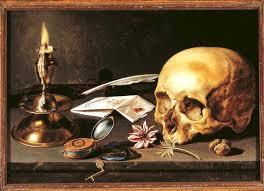
UNIT 8
TASK 2 STUDIO LIGHTING Still Life
Historical and contemporary influences on studio photography
The history of photographic studios and photography dates back to the 1840s with the invention of processes for recording camera pictures, by Henry Fox Talbot and Louis Daguerre. The earliest photographic studios made use of natural daylight to create photographic portraits.

Henry Fox Talbot

Portraits Before Photography
The concept of portraiture first started out in the art world as paintings. Usually, these types of portraits were done to show power, status, and nobility and were typically reserved for the wealthy.
However, once photography became popular in the late 1800s with the release of the very first Kodak cameras, portraiture became popular and was more available to the masses.
Because of their convenience and ability to capture photos of many people – such as a family – all at once without tedious sitting sessions, portrait and self-portrait photography soon replaced paintings in popularity.


The First Portrait Photograph
In 1839, a self-proclaimed "mathematician" named Robert Cornelius captured the first known photograph of himself. Cornelius used a camera obscura to take the photograph in his family's store in Philadelphia—the same way that many artists of the day would use mirrors to trace their portraits or landscapes.
It wasn't until 1841 that he had it developed as a daguerreotype, a process invented by Louis Daguerre. Even then, it was only done so because he wanted to show it off at an exhibition – not because he could see any commercial value in it.

The Daguerreotype
The daguerreotype was the first commercially successful photographic process, and it was also the first permanent photograph. The daguerreotype produced a positive image on a silver surface. It was invented by Louis-Jacques-Mandé Daguerre in 1835 and became publicly available in 1839.
This led to the first photographic portrait studio opening in Boston, Massachusetts, in 1842, which brought portraiture into widespread use across America and Europe. The daguerreotypists were soon joined by photographers who used calotypes (paper negatives) to create portraits of their customers at studios or at home. This practice continued until around 1850, when ambrotypes were introduced as an alternative to wet collodion paper negatives (though they had been around since 1854).

The Rise of Tintypes
Tintypes are a type of vintage photographs made by a direct positive process known as the wet plate collodion process. The term tintype is used to describe both this specific type of photographic image and the photographic case it was housed in.
Tintypes were introduced commercially by George Eastman, who marketed them under the brand name “Kodak No. 2 Brownie Camera”, after his 1888 introduction of the Kodak camera. The Kodak camera was small enough to fit in your pocket and extremely easy to use, even for those who had never seen any kind of camera before.
They became popular during the 19th century due to their affordability and durability, and could last for decades without fading away or getting damaged. These qualities made them an extremely attractive option for portraiture.

The Development of the Dry Plate
Introduced in 1871, dry plates were made of glass and coated with a thin layer of light-sensitive chemicals. These chemicals were exposed to light and then developed as a negative image on the plate itself. This meant that you could keep your camera packed away until right before you took your picture. In other words, there was no longer a need for long exposure times!
For portrait photographers, this meant many things: more time for posing instead of shooting, more flexibility in how they could set up their studio, less risk from chemical spills, and far less expensive equipment needed because each photo only required one exposure. It also allowed them to take pictures outdoors instead of just inside studios where lighting is controlled completely by artificial means. The only downside was that these photos weren't as sharp as wet-plate photos because there wasn't enough time for them to react fully with light during development.

Portraits in Photojournalism
During the Civil War, photojournalists were required to create portraits of soldiers. The first photographs ever taken during a war were captured in 1854 during the Crimean War.
Photographers soon learned that capturing battlefields for posterity was a lucrative business and began traveling with armies to document their victories and defeats. Some of the first photographers who gained fame for their work on military campaigns include Roger Fenton (1819-1869), Matthew Brady (1823-1896), Alexander Gardner (ca. 1821-1913), Timothy O'Sullivan (ca. 1840-1916), Henry Peach Robinson (1830-1901) and Alvin Langdon Coburn (1882).
During the American Great Depression between 1929 and 1939, photographers also began taking photos of families and individuals suffering from this economic disaster in order to expose the world to the very real suffering migrant workers and low-income families were experiencing every day.
These photos were also known as “Dust Bowl Photography.” One of the most iconic photographers of that time is Dorthea Lange because of her notorious 1936 portrait, “Migrant Mother,” featured below.
Photojournalism marked an extremely important milestone in photography, as it was the first time the world could see war, nature, and how other countries lived first-hand without needing to travel.

The Portrait in Modern Times
Portraits have become a staple in photography and can be seen in the media almost anywhere, especially when it comes to celebrities. One of the pioneering photographers of celebrity portraiture is Annie Leibovitz. The simplicity of Leibovitz’s black and white photos is what makes them so striking.
As with many other styles of photography, portraiture has evolved and modernized with the aid of smartphones and devices, and the self-portrait has been made more convenient with the selfie.
The selfie is a form of self-portraiture that has become increasingly popular over the past decade. Although the word “selfie” didn't start becoming used until around 2002 – nearly 150 years after Cornelius snapped his first self-portrait – it didn't really catch on until around 2011, thanks mostly to social media.

Still life studio practice

I have chosen these 2 images with skulls, flowers and shells as an inspiration to use for my still life set up in the studio.

Used a black background because I wanted to make it very dramatic. Used flash, a soft box and a black reflector. My camera settings were 1/125, F16, ISO 100. Used a black cloth to give more depth to the image. One was placed hanging behind the image from a stand, the other one was on the stand. I have thought about the composition, so I placed my objects as I thought was best. Taken a shot, the first ones were too dark, we turned the flash up a bit higher to give more light. Taken another shot, it was still was not what it wanted so I have adjusted the F stop. I have changed it to F11, then F8. I wanted everything in focus so I have again adjusted the studio light source, made it a bit more brighter and went back to F11.

The light was reflecting on the bottle, so I have turned it and it looked much better.
These are the results.
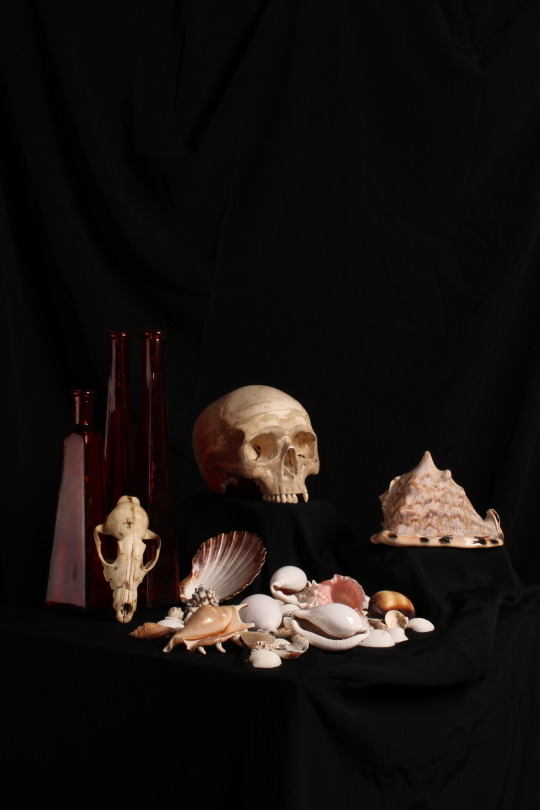
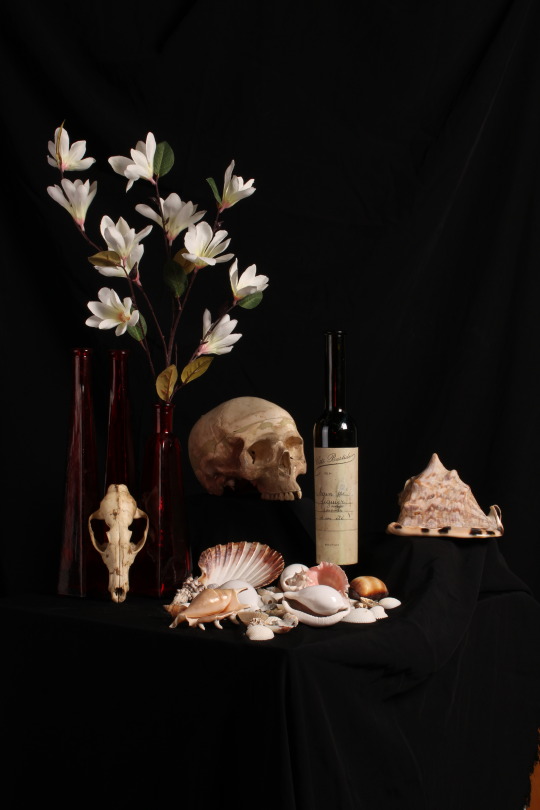
0 notes
Link
1 note
·
View note
Photo
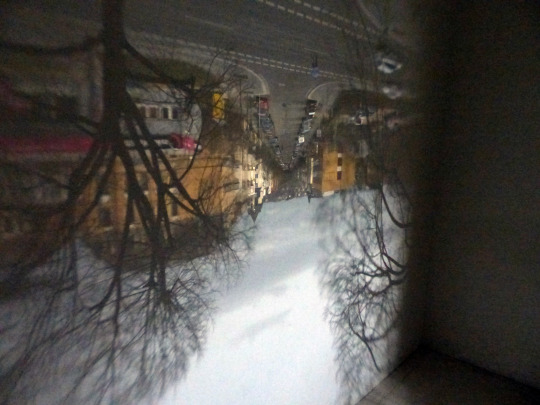
Camera Obscura: An Overview
The camera obscura, also known as a pinhole camera, is an optical device that has been used for centuries to project an image of the surrounding world onto a surface. The device consists of a darkened box or room with a small hole on one side that allows light to enter and form an inverted image on the opposite wall or surface. This article will provide an overview of the camera obscura, its history, and its impact on the development of photography.
History of Camera Obscura
The camera obscura is believed to have originated in ancient China, where it was used to view solar eclipses. The device was further developed in the Islamic world during the Middle Ages, where it was used for scientific purposes such as astronomy and optics. The first written account of the camera obscura in Europe dates back to the 11th century, and it was widely used by artists during the Renaissance to assist in drawing and painting.
Functioning of Camera Obscura
The camera obscura works on the principle of light passing through a small hole, or aperture, and forming an inverted image on a surface. The image that is formed is upside down and reversed left to right, but can be made to appear correct by using a mirror or lens. The size of the image and the amount of detail depends on the size of the aperture and the distance between the aperture and the surface on which the image is projected.
Camera Obscura and Photography
The camera obscura played a significant role in the development of photography, as it provided the basic principles of image formation that are still used in modern cameras. The invention of photographic film and the lens-based camera in the 19th century allowed for the capture of images that were more detailed and accurate than those produced by the camera obscura.
Types of Camera Obscura
There are several types of camera obscura, including portable versions that can be carried around and used outdoors, as well as larger versions that are used in darkened rooms or studios. Modern versions of the camera obscura are used in art installations and as educational tools to teach the principles of optics and image formation.
Conclusion
The camera obscura is a fascinating optical device that has played an important role in the development of photography. From its ancient origins in China to its use by artists during the Renaissance, the camera obscura has provided a way to view the world in a new and unique way. Although it has been largely replaced by more advanced photographic technologies, the camera obscura remains a valuable tool for teaching and understanding the principles of optics and image formation.
Source: History of Camera – From Camera Obscura to SLR
1 note
·
View note
Photo
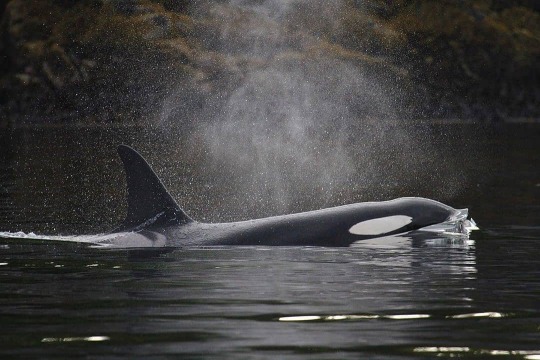
Read 📖 Caption Post by @salishseaorcasquad © 🎞 ✅ @wild_sky_productions The Matriarch: A11 was an incredible mother. Not only to her own daughter, A35, who now continues to grow her own family, but A11 took on the role of adopted mother to Springer, A73. After Springer was re introduced into the Northern resident orca community in 2002 she spent many years in the company of A11 and her family until sadly in 2013, A11 passed away. Her legacy lives on in every recording we make. The beautiful delivery of the N4 passed down from generations before her now transfers to the newest member of the family, A52’s baby, born this year! May her life inspire all the matriarchs out there to carry the strength to nurture the way she did! 🥰 To find out more about how you can support Orcalab and wild Orcas head to orcalab.org and listen live now: 👈🏻🎧 Image 📸 by @wild_sky_productions #orca #matriarch #northernresidentorcas #killerwhale #blackfish #mother #family #community #britishcolumbia #bc #nature #wildlife #canon #photographyThe Matriarch: A11 was an incredible mother. Not only to her own daughter, A35, who now continues to grow her own family, but A11 took on the role of adopted mother to Springer, A73. After Springer was re introduced into the Northern resident orca community in 2002 she spent many years in the company of A11 and her family until sadly in 2013, A11 passed away. Her legacy lives on in every recording we make. The beautiful delivery of the N4 passed down from generations before her now transfers to the newest member of the family, A52’s baby, born this year! May her life inspire all the matriarchs out there to carry the strength to nurture the way she did! 🥰 To find out more about how you can support Orcalab and wild Orcas head to orcalab.org and listen live now: 👈🏻🎧 Image 📸 by @wild_sky_productions #orca #matriarch #northernresidentorcas #killerwhale #blackfish #mother #family #community #britishcolumbia #bc #nature #wildlife #canon #photography (at British Columbia) https://www.instagram.com/p/CF1oxl1B5fN/?igshid=1uqgdl92ajd8w
#orca#matriarch#northernresidentorcas#killerwhale#blackfish#mother#family#community#britishcolumbia#bc#nature#wildlife#canon#photographythe#photography
2 notes
·
View notes
Photo

#photo #photocontestIndonesia #photoboothku #photoshootvideo #photookftheday #photofrenzybooth #photobyir #photoassignment #photographyassociationcertified #photolikesmile #photosdohorse #photographysarawak #photographedbyzamanie #phototexture #photographythe #photoposition #photoillustrator #photographieanalogic #photographerpilihanmakawak #photoed #photographieartistique #photoherts #photographyslive #phototastic #photographymom #photogrvphy #photogallerybyeb #photographynatur #PhotoshootTime #Photographical https://www.instagram.com/p/CCl7wWKJn1R/?igshid=p6k2ncnnfk3k
#photo#photocontestindonesia#photoboothku#photoshootvideo#photookftheday#photofrenzybooth#photobyir#photoassignment#photographyassociationcertified#photolikesmile#photosdohorse#photographysarawak#photographedbyzamanie#phototexture#photographythe#photoposition#photoillustrator#photographieanalogic#photographerpilihanmakawak#photoed#photographieartistique#photoherts#photographyslive#phototastic#photographymom#photogrvphy#photogallerybyeb#photographynatur#photoshoottime#photographical
0 notes
Link
0 notes
Text
Editing photos while listening to Lofi and occasionally gazing at the wintry expanse outside is SUCH a mood.
#photography#notwriting#photographythings#editing#editingphotos#wintryexpanse#doespoeticwordingcountaswriting#mood
0 notes
Photo

Flora's Field Photography
The weight felt odd on his chest; it wasn't really *heavy,* yet the feeling of it around his neck gave him an air of... confidence? "Hey, Flora.." Jazz puffed his chest out, standing next to Carter and grinning, "Can you get a picture of us with the necklaces on?" -- I wonder where he got that necklace...?
11 notes
·
View notes
Photo

The eagle has lifted off . . . . . . . . #grass #nature #eagles #wildlifephotography #photographythings #funtimes #happysnapper #1200d #canon #fortheloveofphotography #noedit #sundayphoto (at Francistown, Botswana)
#photographythings#wildlifephotography#sundayphoto#funtimes#happysnapper#noedit#1200d#eagles#fortheloveofphotography#canon#grass#nature
1 note
·
View note
Text
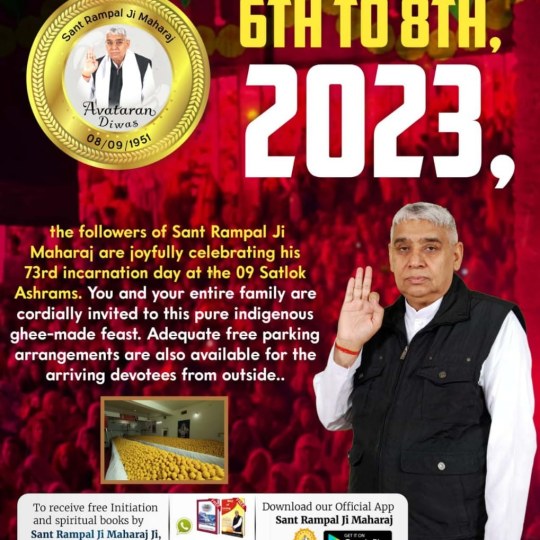
#photographyThe followers of Sant Rampal Ji Maharaj are going to celebrate his incarnation day from 6 to 8 September 2023 with great enthusiasm in 10 Satlok Ashrams. Bhandara will be made from pure desi ghee. The arrangements for accommodation, food and drink in the ashram will be completely free.
0 notes